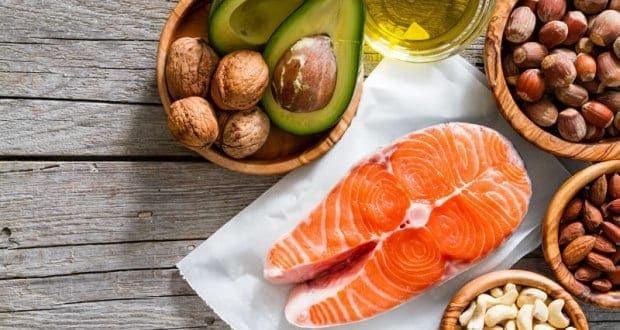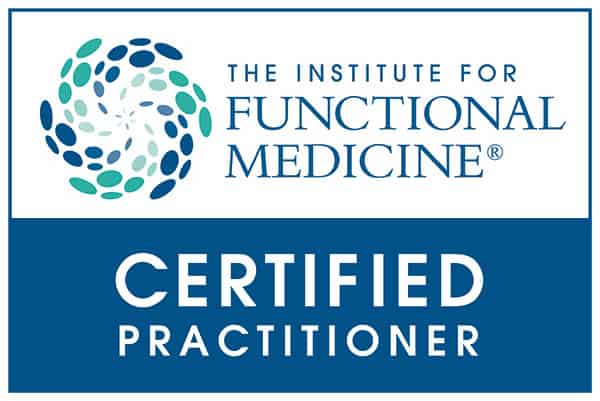1 Jeffrey M. Smith, Genetic Roulette: The Documented Health Risks of Genetically Engineered Foods, Yes! Books, Fairfield, IA USA 2007
2 Kurt Eichenwald, et al, New York Times, �Biotechnology Food: From the Lab to a Debacle,� January 25, 2001
http://www.nytimes.com/2001/01/25/business/25FOOD.html?pagewanted=all
3 Kurt Eichenwald, et al, New York Times, �Biotechnology Food: From the Lab to a Debacle,� January 25, 2001
http://www.nytimes.com/2001/01/25/business/25FOOD.html?pagewanted=all
4 Dan Quayle, �Speech in the Indian Treaty Room of the Old Executive Office Building,� May 26, 1992.
5 For copies of FDA memos, see The Alliance for Bio-Integrity, www.biointegrity.org
6 Steven M. Druker, �How the US Food and Drug Administration approved genetically engineered foods despite the deaths one had caused and
the warnings of its own scientists about their unique risks,� Alliance for Bio-Integrity, http://www.biointegrity.org/ext-summary.html
7 Louis J. Pribyl, �Biotechnology Draft Document, 2/27/92,� March 6, 1992, www.biointegrity.org
http://www.biointegrity.org/FDAdocs/04/view1.html
8 �Statement of Policy: Foods Derived from New Plant Varieties,� Federal Register 57, no. 104 (May 29, 1992): 22991.
9 Linda Kahl, Memo to James Maryanski about Federal Register Document �Statement of Policy: Foods from Genetically Modified Plants,�
Alliance for Bio-Integrity(January 8, 1992) http://www.responsibletechnology.org/fraud/fda-quotes
10 See for example, �Good Enough To Eat?� New Scientist (February 9, 2002), 7.
11 �Health risks of genetically modified foods,� editorial, Lancet, 29 May 1999.
12 �Elements of Precaution: Recommendations for the Regulation of Food Biotechnology in Canada; An Expert Panel Report on the Future of
Food Biotechnology prepared by The Royal Society of Canada at the request of Health Canada Canadian Food Inspection Agency and
Environment Canada� The Royal Society of Canada, January 2001.
13 J. R. Latham, et al., �The Mutational Consequences of Plant Transformation,� The Journal of Biomedicine and Biotechnology 2006, Article ID
25376: 1-7; see also Allison Wilson, et. al., �Transformation-induced mutations in transgenic plants: Analysis and biosafety implications,�
Biotechnology and Genetic Engineering Reviews � Vol. 23, December 2006.
14 P. H. Bao, S. Granata, S. Castiglione, G. Wang, C. Giordani, E. Cuzzoni, G. Damiani, C. Bandi, S. K. Datta, K. Datta, I. Potrykus, A.
Callegarin and F. Sala, “Evidence for genomic changes in transgenic rice (Oryza sativa L.) recovered from protoplasts” Transgen Res 5 (1996):
97-103.; M. Labra, C. Savini, M. Bracale, N. Pelucchi, L. Colombo, M. Bardini and F. Sala, “Genomic changes in transgenic rice (Oryza sativa L.)
plants produced by infecting calli with Agrobacterium tumefaciens,” Plant Cell Rep 20 (2001): 325-330.
15 �Elements of Precaution: Recommendations for the Regulation of Food Biotechnology in Canada; An Expert Panel Report on the Future of
Food Biotechnology prepared by The Royal Society of Canada at the request of Health Canada Canadian Food Inspection Agency and
Environment Canada� The Royal Society of Canada, January 2001.
16 Edwin J. Mathews, Ph.D., in a memorandum to the Toxicology Section of the Biotechnology Working Group. Subject: Analysis of the Major
Plant Toxicants. Dated October 28, 1991
17 Division of Food Chemistry and Technology and Division of Contaminants Chemistry, �Points to Consider for Safety Evaluation of
Genetically Modified Foods: Supplemental Information,� November 1, 1991, http://www.responsibletechnology.org/fraud/fda-quotes
18 Netherwood et al, �Assessing the survival of transgenic plant DNA in the human gastrointestinal tract,� Nature Biotechnology 22 (2004): 2.
19 Division of Food Chemistry and Technology and Division of Contaminants Chemistry, �Points to Consider for Safety Evaluation of
Genetically Modified Foods: Supplemental Information,� November 1, 1991, www.biointegrity.org
20 Charles Benbrook, �Impacts of genetically engineered crops on pesticide use in the U.S. � the first sixteen years,� ENVIRONMENTAL SCIENCES
EUROPE, Vol. 24:24 doi:10.1186/2190-4715-24-24, 28 September 2012. http://www.enveurope.com/content/24/1/24/abstract.
21 Department of Veterinary Medicine, FDA, correspondence June 16, 1993. As quoted in Fred A. Hines, Memo to Dr. Linda Kahl. �Flavr Savr
Tomato: . . . Pathology Branch�s Evaluation of Rats with Stomach Lesions From Three Four-Week Oral (Gavage) Toxicity Studies . . . and an
Expert Panel�s Report,� Alliance for Bio-Integrity (June 16, 1993) http://www.biointegrity.org/FDAdocs/17/view1.html
22 Robert J. Scheuplein, Memo to the FDA Biotechnology Coordinator and others, �Response to Calgene Amended Petition,� Alliance for BioIntegrity
(October 27, 1993) http://www.responsibletechnology.org/fraud/fda-quotes
23 Carl B. Johnson to Linda Kahl and others, �Flavr Savr� Tomato: Significance of Pending DHEE Question,� Alliance for Bio-Integrity
(December 7, 1993) http://www.responsibletechnology.org/fraud/fda-quotes
24 Arpad Pusztai, �Genetically Modified Foods: Are They a Risk to Human/Animal Health?� June 2001 Action Bioscience
www.actionbioscience.org/biotech/pusztai.html
25 Nagui H. Fares, Adel K. El-Sayed, �Fine Structural Changes in the Ileum of Mice Fed on Endotoxin Treated Potatoes and Transgenic
Potatoes,� Natural Toxins 6, no. 6 (1998): 219�233.
26 Stanley W. B. Ewen and Arpad Pusztai, �Effect of diets containing genetically modified potatoes expressing Galanthus nivalis lectin on rat
small intestine,� Lancet, 1999 Oct 16; 354 (9187): 1353-4.
27 Arpad Pusztai, �Facts Behind the GM Pea Controversy: Epigenetics, Transgenic Plants & Risk Assessment,� Proceedings of the Conference,
December 1st 2005 (Frankfurtam Main, Germany: Literaturhaus, 2005). http://www.oeko.de/oekodoc/277/2006-002-en.pdf
28 Arpad Pusztai, �Can science give us the tools for recognizing possible health risks of GM food,� Nutrition and Health, 2002, Vol 16 Pp 73-84.
29 John M. Burns, �13-Week Dietary Subchronic Comparison Study with MON 863 Corn in Rats Preceded by a 1-Week Baseline Food
Consumption Determination with PMI Certified Rodent Diet #5002,� December 17, 2002
http://www.monsanto.com/pdf/products/fullratstudy863.pdf
30 R. Tudisco, P. Lombardi, F. Bovera, D. d�Angelo, M. I. Cutrignelli, V. Mastellone, V. Terzi, L. Avallone, F. Infascelli, �Genetically Modified
Soya Bean in Rabbit Feeding: Detection of DNA Fragments and Evaluation of Metabolic Effects by Enzymatic Analysis,� Animal Science 82
(2006): 193�199.
31 Comments to ANZFA about Applications A346, A362 and A363 from the Food Legislation and Regulation Advisory Group (FLRAG) of the
Public Health Association of Australia (PHAA) on behalf of the PHAA, �Food produced from glyphosate-tolerant canola line GT73.�
32 M. Malatesta, C. Caporaloni, S. Gavaudan, M. B. Rocchi, S. Serafini, C. Tiberi, G. Gazzanelli, �Ultrastructural Morphometrical and
Immunocytochemical Analyses of Hepatocyte Nuclei from Mice Fed on Genetically Modified Soybean,� Cell Struct Funct. 27 (2002): 173�180
33 Jeffrey M. Smith, Genetic Roulette: The Documented Health Risks of Genetically Engineered Foods, Yes! Books, Fairfield, IA USA 2007
34 Irina Ermakova, �Experimental Evidence of GMO Hazards,� Presentation at Scientists for a GM Free Europe, EU Parliament, Brussels, June
12, 2007
35 Arpad Pusztai, �Can Science Give Us the Tools for Recognizing Possible Health Risks for GM Food?� Nutrition and Health 16 (2002): 73�84.
36 S. Leeson, �The Effect of Glufosinate Resistant Corn on Growth of Male Broiler Chickens,� Department of Animal and Poultry Sciences,
University of Guelph, Report No. A56379, July 12, 1996.
37 Malatesta, et al, �Ultrastructural Analysis of Pancreatic Acinar Cells from Mice Fed on Genetically modified Soybean,� J Anat. 2002
November; 201(5): 409�415; see also M. Malatesta, M. Biggiogera, E. Manuali, M. B. L. Rocchi, B. Baldelli, G. Gazzanelli, �Fine Structural
Analyses of Pancreatic Acinar Cell Nuclei from Mice Fed on GM Soybean,� Eur J Histochem 47 (2003): 385�388.
38 Arpad Pusztai, �Can science give us the tools for recognizing possible health risks of GM food,� Nutrition and Health, 2002, Vol 16 Pp 73-84
39 R. Tudisco, P. Lombardi, F. Bovera, D. d�Angelo, M. I. Cutrignelli, V. Mastellone, V. Terzi, L. Avallone, F. Infascelli, �Genetically Modified
Soya Bean in Rabbit Feeding: Detection of DNA Fragments and Evaluation of Metabolic Effects by Enzymatic Analysis,� Animal Science 82
(2006): 193�199.
40 John M. Burns, �13-Week Dietary Subchronic Comparison Study with MON 863 Corn in Rats Preceded by a 1-Week Baseline Food
Consumption Determination with PMI Certified Rodent Diet #5002,� December 17, 2002
http://www.monsanto.com/pdf/products/fullratstudy863.pdf
41 R. Tudisco, P. Lombardi, F. Bovera, D. d�Angelo, M. I. Cutrignelli, V. Mastellone, V. Terzi, L. Avallone, F. Infascelli, �Genetically Modified
Soya Bean in Rabbit Feeding: Detection of DNA Fragments and Evaluation of Metabolic Effects by Enzymatic Analysis,� Animal Science 82
(2006): 193�199.
42 Arpad Pusztai, �Can science give us the tools for recognizing possible health risks of GM food,� Nutrition and Health, 2002, Vol 16 Pp 73-84
43 de Vend�mois JS, Roullier F, Cellier D, S�ralini GE. A Comparison of the Effects of Three GM Corn Varieties on Mammalian Health. Int J
Biol Sci 2009; 5:706-726. Available from http://www.biolsci.org/v05p0706.htm
44 S�ralini, G.-E., et al. Long term toxicity of a Roundup herbicide and a Roundup-tolerant genetically modified maize. Food
Chem. Toxicol. (2012), http://dx.doi.org/10.1016/j.fct.2012.08.005
45 Irina Ermakova, �Experimental Evidence of GMO Hazards,� Presentation at Scientists for a GM Free Europe, EU Parliament, Brussels, June
12, 2007
46 L. Vecchio et al, �Ultrastructural Analysis of Testes from Mice Fed on Genetically Modified Soybean,� European Journal of Histochemistry
48, no. 4 (Oct�Dec 2004):449�454.
47 Oliveri et al., �Temporary Depression of Transcription in Mouse Pre-implantion Embryos from Mice Fed on Genetically Modified Soybean,�
48th Symposium of the Society for Histochemistry, Lake Maggiore (Italy), September 7�10, 2006.
48 Fl�via Bittencourt Brasil, et al, �The Impact of Dietary Organic and Transgenic Soy on the Reproductive System of Female Adult Rat,� The
Anatomical Record: Advances in Integrative Anatomy and Evolutionary Biology Volume 292, Issue 4, pages 587-594, April 2009
http://onlinelibrary.wiley.com/doi/10.1002/ar.20878/abstract
49 Jeffrey M. Smith, �Genetically Modified Soy Linked to Sterility, Infant Mortality,� based on correspondence with study authors and press
reports, Institute for Responsible Technology http://www.responsibletechnology.org/article-gmo-soy-linked-to-sterility
50 Alberta Velimirov and Claudia Binter, �Biological effects of transgenic maize NK603xMON810 fed in long term reproduction studies in
mice,� Forschungsberichte der Sektion IV, Band 3/2008. Report-Federal Ministry of Health, Family and Youth. 2008.
http://www.biosicherheit.de/pdf/aktuell/zentek_studie_2008.pdf
51 I.V.Ermakova, �Genetically Modified Organisms and Biological Risks,� Proceedings of International Disaster Reduction Conference (IDRC)
Davos, Switzerland August 27th � September 1st, 2006: 168�172. http://eco-irina-ermakova.narod.ru/eng/art/art16.html
52 Irina Ermakova, �Genetically modified soy leads to the decrease of weight and high mortality of rat pups of the first generation. Preliminary
studies,� Ecosinform 1 (2006): 4�9.
53 Irina Ermakova, �Experimental Evidence of GMO Hazards,� Presentation at Scientists for a GM Free Europe, EU Parliament, Brussels, June
12, 2007
54 I.V.Ermakova �GMO: Life itself intervened into the experiments,� Letter, EcosInform N2 (2006): 3�4.
55 Jeffrey M. Smith, Genetic Roulette: The Documented Health Risks of Genetically Engineered Foods, Yes! Books, Fairfield, IA USA 2007
56 �Mortality in Sheep Flocks after Grazing on Bt Cotton Fields�Warangal District, Andhra Pradesh� Report of the Preliminary Assessment,
April 2006, http://gmwatch.org/latest-listing/1-news-items/6416-mortality-in-sheep-flocks-after-grazing-on-bt-cotton-fields-warangal-districtandhra-pradesh-2942006
57 Personal communication and visit by Jeffrey Smith with village members, near Warangal, Andhra Pradesh, January 2009.
58 John M. Burns, �13-Week Dietary Subchronic Comparison Study with MON 863 Corn in Rats Preceded by a 1-Week Baseline Food
Consumption Determination with PMI Certified Rodent Diet #5002,� December 17, 2002
http://www.monsanto.com/monsanto/content/sci_tech/prod_safety/fullratstudy.pdf, see also St�phane Foucart, �Controversy Surrounds a GMO,�
Le Monde, 14 December 2004; and Jeffrey M. Smith, �Genetically Modified Corn Study Reveals Health Damage and Cover-up,� Spilling the
Beans, June 2005, http://www.seedsofdeception.com/Public/Newsletter/June05GMCornHealthDangerExposed/index.cfm
59 Arpad Pusztai, �Can science give us the tools for recognizing possible health risks of GM food,� Nutrition and Health, 2002, Vol 16 Pp 73-84
60 V. E. Prescott, et al, �Transgenic Expression of Bean r-Amylase Inhibitor in Peas Results in Altered Structure and
Immunogenicity,� Journal of Agricultural Food Chemistry (2005): 53.
61 Yearly food sensitivity assessment of York Laboratory, as reported in Mark Townsend, �Why soya is a hidden destroyer,� Daily Express,
March 12, 1999.
62 G. A. Kleter and A. A. C. M. Peijnenburg, �Screening of transgenic proteins expressed in transgenic food crops for the presence of short amino
acid sequences indentical to potential, IgE-binding linear epitopes of allergens,� BMC Structural Biology 2 (2002): 8�19.
63 Netherwood et al, �Assessing the survival of transgenic plant DNA in the human gastrointestinal tract,� Nature Biotechnology 22 (2004): 2.
64 Hye-Yung Yum, Soo-Young Lee, Kyung-Eun Lee, Myung-Hyun Sohn, Kyu-Earn Kim, �Genetically Modified and Wild Soybeans: An
immunologic comparison,� Allergy and Asthma Proceedings 26, no. 3 (May�June 2005): 210-216(7).
65 Stephen R. Padgette et al, �The Composition of Glyphosate-Tolerant Soybean Seeds Is Equivalent to That of Conventional Soybeans,� The
Journal of Nutrition 126, no. 4, (April 1996); including data in the journal archives from the same study; see also A. Pusztai and S. Bardocz,
�GMO in animal nutrition: potential benefits and risks,� Chapter 17, Biology of Nutrition in Growing Animals (Elsevier, 2005).
66 Manuela Malatesta, et al, �Ultrastructural Analysis of Pancreatic Acinar Cells from Mice Fed on Genetically modified Soybean,� Journal of
Anatomy 201, no. 5 (November 2002): 409; see also M. Malatesta, M. Biggiogera, E. Manuali, M. B. L. Rocchi, B. Baldelli, G. Gazzanelli, �Fine
Structural Analyses of Pancreatic Acinar Cell Nuclei from Mice Fed on GM Soybean,� Eur J Histochem 47 (2003): 385�388.
67 See for example, Scott H. Sicherer et al., �Prevalence of peanut and tree nut allergy in the United States determined by means of a random digit
dial telephone survey: A 5-year follow-up study,� Journal of allergy and clinical immunology, March 2003, vol. 112, n 6, 1203-1207); and Ricki
Helm et al., �Hypoallergenic Foods�Soybeans and Peanuts,� Information Systems for Biotechnology News Report, October 1, 2002.
68 Vazquez et al, “Intragastric and intraperitoneal administration of Cry1Ac protoxin from Bacillus thuringiensis induces systemic and mucosal
antibody responses in mice,” Life Sciences, 64, no. 21 (1999): 1897�1912; Vazquez et al, �Characterization of the mucosal and systemic immune
response induced by Cry1Ac protein from Bacillus thuringiensis HD 73 in mice,� Brazilian Journal of Medical and Biological Research 33 (2000):
147�155.
69 R. I. V�zquez, L. Moreno-Fierros, L. Neri-Baz�n, et al., �Bacillus thuringiensis Cry1Ac Protoxin Is a Potent Systemic and Mucosal Adjuvant,�
Scandinavian Journal of Immunology 49 (1999): 578�84. See also Vazquez-Padron, RI. Et al. (2000b) Characterization of the mucosal and
systemic immune response induced by Cry1Ac protein from Bacillus thuringiensis HD 73 in mice. Brazilian Journal of Medical and Biological
Research 33, 147-155.
70 Nagui H. Fares, Adel K. El-Sayed, �Fine Structural Changes in the Ileum of Mice Fed on Endotoxin Treated Potatoes and Transgenic
Potatoes,� Natural Toxins 6, no. 6 (1998): 219�233.
71 Alberto Finamore, et al, �Intestinal and Peripheral Immune Response to MON810 Maize Ingestion in Weaning and Old Mice,� J. Agric. Food
Chem., 2008, 56 (23), pp 11533�11539, November 14, 2008
72 Washington State Department of Health, �Report of health surveillance activities: Asian gypsy moth control program,� (Olympia, WA:
Washington State Dept. of Health, 1993).
73 M. Green, et al., �Public health implications of the microbial pesticide Bacillus thuringiensis: An epidemiological study, Oregon, 1985-86,�
Amer. J. Public Health 80, no. 7(1990): 848�852.
74 M.A. Noble, P.D. Riben, and G. J. Cook, �Microbiological and epidemiological surveillance program to monitor the health effects of Foray
48B BTK spray� (Vancouver, B.C.: Ministry of Forests, Province of British Columbi, Sep. 30, 1992).
75 A. Edamura, MD, �Affidavit of the Federal Court of Canada, Trial Division. Dale Edwards and Citizens Against Aerial Spraying vs. Her
Majesty the Queen, Represented by the Minister of Agriculture,� (May 6, 1993); as reported in Carrie Swadener, �Bacillus thuringiensis (B.t.),�
Journal of Pesticide Reform, 14, no, 3 (Fall 1994).
76 J. R. Samples, and H. Buettner, �Ocular infection caused by a biological insecticide,� J. Infectious Dis. 148, no. 3 (1983): 614; as reported in
Carrie Swadener, �Bacillus thuringiensis (B.t.)�, Journal of Pesticide Reform 14, no. 3 (Fall 1994)
77 M. Green, et al., �Public health implications of the microbial pesticide Bacillus thuringiensis: An epidemiological study, Oregon, 1985-86,�
Amer. J. Public Health, 80, no. 7 (1990): 848�852.
78 A. Edamura, MD, �Affidavit of the Federal Court of Canada, Trial Division. Dale Edwards and Citizens Against Aerial Spraying vs. Her
Majesty the Queen, Represented by the Minister of Agriculture,� (May 6, 1993); as reported in Carrie Swadener, �Bacillus thuringiensis (B.t.),�
Journal of Pesticide Reform, 14, no, 3 (Fall 1994).
79 Carrie Swadener, �Bacillus thuringiensis (B.t.),� Journal of Pesticide Reform 14, no. 3 (Fall 1994).
80 Terje Traavik and Jack Heinemann, �Genetic Engineering and Omitted Health Research: Still No Answers to Ageing Questions, 2006. Cited in
their quote was: G. Stotzky, �Release, persistence, and biological activity in soil of insecticidal proteins from Bacillus thuringiensis,� found in
Deborah K. Letourneau and Beth E. Burrows, Genetically Engineered Organisms. Assessing Environmental and Human Health Effects (cBoca
Raton, FL: CRC Press LLC, 2002), 187�222.
81 See for example, A. Dutton, H. Klein, J. Romeis, and F. Bigler, �Uptake of Bt-toxin by herbivores feeding on transgenic maize and
consequences for the predator Chrysoperla carnea,� Ecological Entomology 27 (2002): 441�7; and J. Romeis, A. Dutton, and F. Bigler, �Bacillus
thuringiensis toxin (Cry1Ab) has no direct effect on larvae of the green lacewing Chrysoperla carnea (Stephens) (Neuroptera: Chrysopidae),�
Journal of Insect Physiology 50, no. 2�3 (2004): 175�183.
82 Mesnage R, Clair E, Gress S, Then C, Sz�k�cs A, S�ralini, GE. (2012). Cytotoxicity on human cells of Cry1Ab and Cry1Ac Bt insecticidal
toxins alone or with a glyphosate-based herbicide. J. Appl. Toxicol. doi: 10.1002/jat.2712
83 Aris A, Leblanc S. Maternal and fetal exposure to pesticides associated to genetically modified foods in Eastern Townships of Quebec, Canada.
Reprod Toxicol (2011), doi:10.1016/j.reprotox.2011.02.004 http://www.ncbi.nlm.nih.gov/pubmed/21338670
84 N. Tomlinson of UK MAFF’s Joint Food Safety and Standards Group 4, December 1998 letter to the U.S. FDA, commenting on its draft
document, �Guidance for Industry: Use of Antibiotic Resistance Marker Genes in Transgenic Plants.�
85 Jeffrey M. Smith, �Bt-maize (corn) during pollination, may trigger disease in people living near the cornfield,� Press Release, February 2004,
http://www.responsibletechnology.org/gmo-dangers/health-risks/articles-about-risks-by-jeffrey-smith/Genetically-Engineered-Foods-May-CauseRising-Food-Allergies-Genetically-Engineered-Corn-June-2007;
and Allen V. Estabillo, �Farmer’s group urges ban on planting Bt corn; says it
could be cause of illnesses,� Mindanews, October 19, 2004 http://www.gmwatch.org/latest-listing/43-2004/5635-farmers-group-urges-ban-onplanting-bt-corn-20102004
86 Mae-Wan Ho, �GM Ban Long Overdue, Dozens Ill & Five Deaths in the Philippines,� ISIS Press Release, June 2, 2006. http://www.isis.org.uk/GMBanLongOverdue.php
87 Ashish Gupta et. al., �Impact of Bt Cotton on Farmers� Health (in Barwani and Dhar District of Madhya Pradesh),� Investigation Report, Oct�
Dec 2005.
88 Jeffrey M. Smith, Genetic Roulette: The Documented Health Risks of Genetically Engineered Foods, Yes! Books, Fairfield, IA USA 2007
89 E. Ann Clark, �Food Safety of GM Crops in Canada: toxicity and allergenicity,� GE Alert, 2000.
http://www.plant.uoguelph.ca/research/homepages/eclark/safety.htm
90 FLRAG of the PHAA of behalf of the PHAA, �Comments to ANZFA about Applications A372, A375, A378 and A379.�
91 Judy Carman, �Is GM Food Safe to Eat?� in R. Hindmarsh, G. Lawrence, eds., Recoding Nature Critical Perspectives on Genetic Engineering
(Sydney: UNSW Press, 2004): 82�93.
92 Judy Carman, �Is GM Food Safe to Eat?� in R. Hindmarsh, G. Lawrence, eds., Recoding Nature Critical Perspectives on Genetic Engineering
(Sydney: UNSW Press, 2004): 82�93.
93 FLRAG, �Comments to ANZFA about Applications A346, A362 and A363,� http://www.iher.org.au/
94 Doug Gurian-Sherman, �Holes in the Biotech Safety Net, FDA Policy Does Not Assure the Safety of Genetically Engineered Foods,� Center
for Science in the Public Interest, http://www.cspinet.org/new/pdf/fda_report__final.pdf
95 Bill Freese, �The StarLink Affair, Submission by Friends of the Earth to the FIFRA Scientific Advisory Panel considering Assessment of
Additional Scientific Information Concerning StarLink Corn,� July 17�19, 2001.
96 FDA Letter, Letter from Alan M. Rulis, Office of Premarket Approval, Center for Food Safety and Applied Nutrition, FDA to Dr. Kent Croon,
Regulatory Affairs Manager, Monsanto Company, Sept 25, 1996. See Letter for BNF No. 34 at
http://www.fda.gov/Food/Biotechnology/Submissions/ucm161107.htm
97 �Elements of Precaution: Recommendations for the Regulation of Food Biotechnology in Canada; An Expert Panel Report on the Future of
Food Biotechnology prepared by The Royal Society of Canada at the request of Health Canada Canadian Food Inspection Agency and
Environment Canada� The Royal Society of Canada, January 2001. http://www.canadians.org/food/documents/rsc_feb05.pdf
98 FIFRA Scientific Advisory Panel (SAP), Open Meeting, July 17, 2001. http://www.epa.gov/scipoly/sap/meetings/2001/july/julyfinal.pdf
99 Bill Freese, Crop testing, New Scientist, Letter to the Editor, issue 2530, December 17, 2005
100 M. Cretenet, J. Goven, J. A. Heinemann, B. Moore, and C. Rodriguez-Beltran, �Submission on the DAR for application A549 Food Derived
from High-Lysine Corn LY038: to permit the use in food of high-lysine corn, 2006, www.inbi.canterbury.ac.nz
101 Marc Lapp� and Britt Bailey, �ASA Response,� June 25, 1999, www.environmentalcommons.org/cetos/articles/asaresponse.html
102 Bill Freese, �The StarLink Affair, Submission by Friends of the Earth to the FIFRA Scientific Advisory Panel considering Assessment of
Additional Scientific Information Concerning StarLink Corn,� July 17-19, 2001
103 Paul P. Groenewegen, Brian W. McBride, John H. Burton, Theodore H. Elsasser. “Bioactivity of Milk from bST-Treated Cows.” J. Nutrition
120, 1990, pp. 514-519
104 Judith C. Juskevich and C. Greg Guyer. “Bovine Growth Hormone: Human Food Safety Evaluation.” Science, vol. 249. August 24, 1990, pp.
875-884
105 Pete Hardin, �rbGH: Appropriate Studies Haven�t Been Done,� The Milkweed, July 2000
106 See for example, Doug Gurian-Sherman, �Holes in the Biotech Safety Net, FDA Policy Does Not Assure the Safety of Genetically Engineered
Foods,� Center for Science in the Public Interest, http://www.cspinet.org/new/pdf/fda_report__final.pdf
107 S. R. Padgette, N. B.Taylor, D. L. Nida, M. R. Bailey, J. MacDonald, L. R. Holden, R. L. Fuchs, �The composition of glyphosate-tolerant
soybean seeds is equivalent to that of conventional soybeans,� J. Nutr. 126 (1996):702�716.
108 B. G. Hammond, J. L. Vicini, G. F. Hartnell, M. W. Naylor, C. D. Knight, E. H. Robinson, R. L. Fuchs, and S. R. Padgette, �The feeding
value of soybeans fed to rats, chickens, catfish, and dairy cattle is not altered by genetic incorporation of glyphosate tolerance,� J. Nutr. 126
(1996): 717�727.
109 A. Pusztai and S. Bardocz, �GMO in animal nutrition: potential benefits and risks,� Chapter 17, Biology of Nutrition in Growing Animals
(Elsevier, October 2005). earlier
110 Ian F. Pryme and Rolf Lembcke, �In Vivo Studies on Possible Health Consequences of Genetically Modified Food and Feed�with Particular
Regard to Ingredients Consisting of Genetically Modified Plan Materials,� Nutrition and Health 17(2003): 1�8.
111 Andreas Rang, et al, �Detection of RNA variants transcribed from the transgene in Roundup Ready soybean,� Eur Food
Res Technol 220 (2005): 438�443.
112 Ian F. Pryme and Rolf Lembcke, �In Vivo Studies on Possible Health Consequences of Genetically Modified Food and Feed�with Particular
Regard to Ingredients Consisting of Genetically Modified Plan Materials,� Nutrition and Health 17(2003): 1�8.
113 Arpad Pusztai, �Can science give us the tools for recognizing possible health risks of GM food,� Nutrition and Health, 2002, Vol 16 Pp 73-84;
Stanley W. B. Ewen and Arpad Pusztai, �Effect of diets containing genetically modified potatoes expressing Galanthus nivalis lectin on rat small
intestine,� Lancet, 1999 Oct 16; 354 (9187): 1353-4; Arpad Pusztai, �Genetically Modified Foods: Are They a Risk to Human/Animal Health?�
June 2001 Action Bioscience http://www.actionbioscience.org/biotech/pusztai.html; and A. Pusztai and S. Bardocz, �GMO in animal nutrition:
potential benefits and risks,� Chapter 17, Biology of Nutrition in Growing Animals, R. Mosenthin, J. Zentek and T. Zebrowska (Eds.) Elsevier,
October 2005
114 V. E. Prescott, et al, �Transgenic Expression of Bean r-Amylase Inhibitor in Peas Results in Altered Structure and Immunogenicity,� Journal
of Agricultural Food Chemistry (2005): 53.
115 J. Lexchin, L. A. Bero, B. Djulbegovic, and O. Clark, �Pharmaceutical industry sponsorship and research outcome and quality: systematic
review,� BMJ 326 (2003):1167�1176.
116 Mark Friedberg, et al, �Evaluation of Conflict of Interest in Economic Analyses of New Drugs Used in Oncology,� JAMA 282 (1999):1453�
1457.
117 Suzanne Wuerthele quoted here: http://archive.sare.org/sanet-mg/archives/html-home/23-html/0195.html
118 �Elements of Precaution,� The Royal Society of Canada, January 2001. http://www.canadians.org/food/documents/rsc_feb05.pdf
119 Friends of the Earth Europe, �Throwing Caution to the Wind: A review of the European Food Safety Authority and its work on genetically
modified foods and crops,� November 2004.
120 European Communities submission to World Trade Organization dispute panel, 28 January 2005, reported in Hidden uncertainties – risks of
GMOs, 23 April 2006, Friends of the Earth / Greenpeace http://www.non-gm-farmers.com/news_print.asp?ID=2731
121 EU Regulation 178/2002 (Article 30.4)
122 Friends of the Earth Europe, �Throwing Caution to the Wind: A review of the European Food Safety Authority and its work on genetically
modified foods and crops,� November 2004.
123 �Greenpeace exposes Government-Monsanto nexus to cheat Indian farmers: calls on GEAC to revoke BT cotton permission,� Press release,
March 3, 2005, http://www.greenpeace.org/india_en/news/details?item_id=771071
124 Jeffrey M. Smith, Seeds of Deception, (Iowa: Yes! Books, 2003), 224.
125 �Monsanto Bribery Charges in Indonesia by DoJ and USSEC,� Third World Network, Malaysia, Jan 27, 2005,
http://www.mindfully.org/GE/2005/Monsanto-Indonesia-Bribery27jan05.htm
126 Jeffrey M. Smith, Seeds of Deception, Yes! Books, Fairfield, Iowa 2003
127 Karen Charman, The Professor Who Can Read Your Mind, PR Watch Newsletter Fourth Quarter 1999, Volume 6, No. 4
128 http://www.gmwatch.org/latest-listing/41-2002/3068-support-for-food-biotechnology-holds-in-the-us-
129 Estimates of increased IGF-1 levels vary considerably. In Mepham et al, �Safety of milk from cows treated with bovine somatotropin,� The
Lancet 2 (1994):197, IGF-1 levels were up to 10 times higher. The methods used may also underestimate IGF-1 levels considerably. See Samuel
S. Epstein, �Unlabeled Milk From Cows Treated With Biosynthetic Growth Hormones: A Case of Regulatory Abdication,� International Journal
of Health Services 26(1996): 173�185; and Samuel S. Epstein, What�s In Your Milk? (Victoria, British Columbia, Canada:Trafford Publishing,
2006), 197�204.
130 For a review of literature linking elevated levels of IGF-1 with increased risks of breast, colon and prostate cancers, see Samuel S. Epstein,
What�s In Your Milk?, 197�204.
131 Gary Steinman, �Mechanisms of Twinning VII. Effect of Diet and Heredity on the Human Twinning Rate,� Journal of Reproductive
Medicine, May 2006; S.E. Echternkamp et al, �Ovarian Follicular Development in Cattle Selected for Twin Ovulations and Births,� Journal of
Animal Science 82 no. 2 (2004): 459�471; and S. E. Echternkamp et al, �Concentrations of insulin-like growth factor-I in blood and ovarian
follicular fluid of cattle selected for twins,� Biology of Reproduction, 43(1990): 8�14.
132 Powell D.A.; Blaine K.; Morris S.; Wilson J., Agronomic and consumer considerations for Bt and conventional sweet-corn, British Food
Journal, Volume: 105, Issue: 10, Page: 700-713 (Nov 2003)
133 GM Nation? The findings of the public debate, http://www.gmnation.org.uk/ut_09/ut_9_6.htm#summary
134 To see the Toronto Star photo in Laidlaw�s book, go to http://www.gmwatch.org/p1temp.asp?pid=72&page=1 or
http://www.powerbase.info/index.php/Shane_Morris
135 Corn Fakes, Private Eye, No. 1194, 28 September-11 October 2007 http://www.gmwatch.org/latest-listing/46-2007/7525-award-winningpaper-qa-flagrant-fraudq-cambridge-expert-2692007
136 Tim Lambert, Would you eat wormy corn?, September 7 2007
http://scienceblogs.com/deltoid/2007/09/would_you_eat_wormy_sweet_corn.php
137 �Genetically modified foods, who knows how safe they are?� CBC News and Current Affairs, September 25, 2006.
138 Mike Zelina, et al., The Health Effects of Genetically Engineered Crops on San Luis Obispo County,� A Citizen Response to the SLO Health
Commission GMO Task Force Report, 2006.
139 Bill Lambrecht, Dinner at the New Gene Caf�, St. Martin’s Press, September 2001, pg 139
Photo credits
Stanley W. B. Ewen and Arpad Pusztai, �Effect of diets containing genetically modified potatoes expressing Galanthus nivalis lectin on rat small
intestine,� Lancet, 1999 Oct 16; 354 (9187): 1353-4.
M. Malatesta, C. Caporaloni, S. Gavaudan, M. B. Rocchi, S. Serafini, C. Tiberi, G. Gazzanelli, �Ultrastructural Morphometrical and
Immunocytochemical Analyses of Hepatocyte Nuclei from Mice Fed on Genetically Modified Soybean,� Cell Struct Funct. 27 (2002): 173�180
Irina Ermakova, �Experimental Evidence of GMO Hazards,� Presentation at Scientists for a GM Free Europe, EU Parliament, Brussels, June 12,
2007
Irina Ermakova, �Genetically modified soy leads to the decrease of weight and high mortality of rat pups of the first generation. Preliminary
studies,� Ecosinform 1 (2006): 4�9.



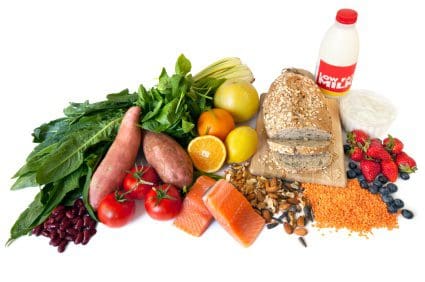 5. Makes You Smarter
5. Makes You Smarter

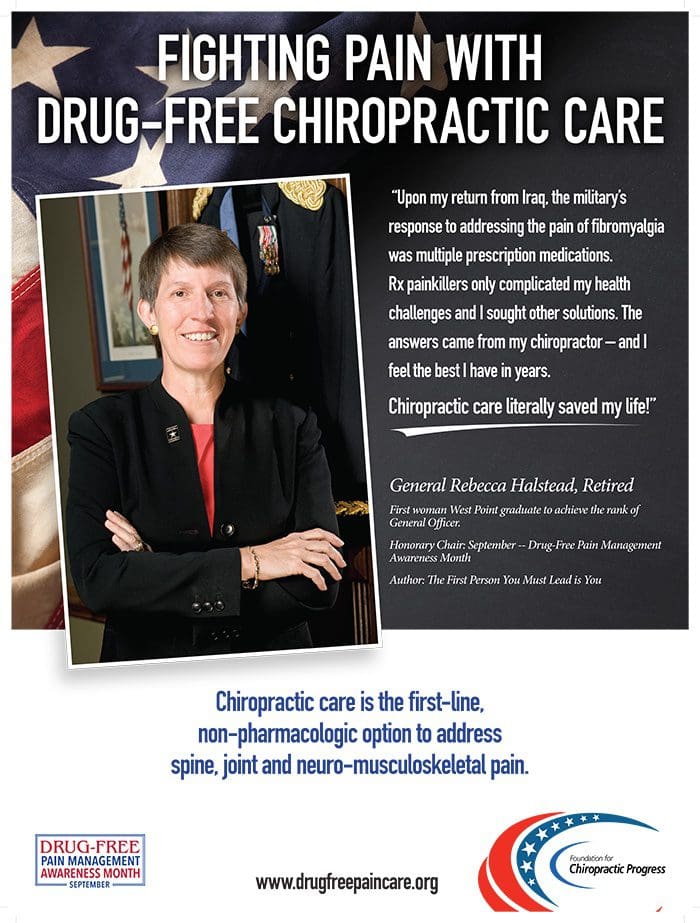
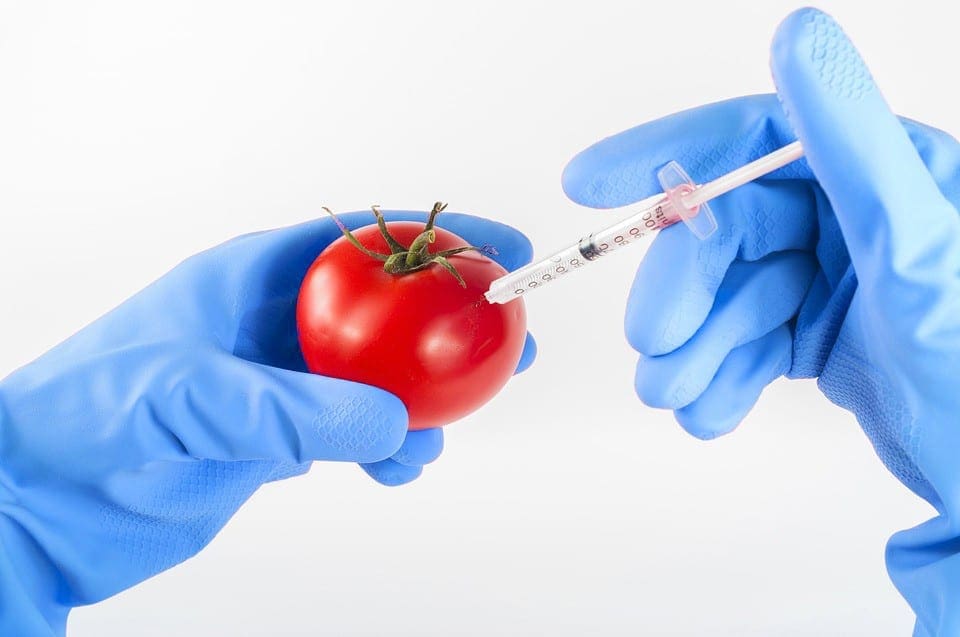
 Rhetoric from the United States government since the early 1990s proclaims that GM foods are no different from their natural counterparts that have existed for centuries. The Food and Drug Administration (FDA) has labeled them �Generally Recognized as Safe,� or GRAS. This status allows a product to be commercialized without any additional testing. According to US law, to be considered GRAS the substance must be the subject of a substantial amount of peer-reviewed published studies (or equivalent) and there must be overwhelming consensus among the scientific community that the product is safe. GM foods had neither. Nonetheless, in a precedent-setting move in 1992 that some experts contend was illegal, the FDA declared that GM crops are GRAS as long as their producers say they are. Thus, the FDA does not require any safety evaluations or labeling of GMOs. A company can even introduce a GM food to the market without telling the agency.
Rhetoric from the United States government since the early 1990s proclaims that GM foods are no different from their natural counterparts that have existed for centuries. The Food and Drug Administration (FDA) has labeled them �Generally Recognized as Safe,� or GRAS. This status allows a product to be commercialized without any additional testing. According to US law, to be considered GRAS the substance must be the subject of a substantial amount of peer-reviewed published studies (or equivalent) and there must be overwhelming consensus among the scientific community that the product is safe. GM foods had neither. Nonetheless, in a precedent-setting move in 1992 that some experts contend was illegal, the FDA declared that GM crops are GRAS as long as their producers say they are. Thus, the FDA does not require any safety evaluations or labeling of GMOs. A company can even introduce a GM food to the market without telling the agency. Taylor�s GMO policy needed to create the impression that unintended effects from GM crops were not an issue. Otherwise their GRAS status would be undermined and they would need the extensive testing and labels that are normally required for food additives. But internal memos made public from a lawsuit showed that the overwhelming consensus among the agency scientists was that GM crops can have unpredictable, hard-to-detect side effects. Various departments and experts spelled these out in detail, listing allergies, toxins, nutritional effects, and new diseases as potential dangers. They urged superiors to require long-term safety studies.5 In spite of the warnings, according to public interest attorney Steven Druker who studied the FDA�s internal files, �References to the unintended negative effects of bioengineering were progressively deleted from drafts of the policy statement (over the protests of agency scientists).�6
Taylor�s GMO policy needed to create the impression that unintended effects from GM crops were not an issue. Otherwise their GRAS status would be undermined and they would need the extensive testing and labels that are normally required for food additives. But internal memos made public from a lawsuit showed that the overwhelming consensus among the agency scientists was that GM crops can have unpredictable, hard-to-detect side effects. Various departments and experts spelled these out in detail, listing allergies, toxins, nutritional effects, and new diseases as potential dangers. They urged superiors to require long-term safety studies.5 In spite of the warnings, according to public interest attorney Steven Druker who studied the FDA�s internal files, �References to the unintended negative effects of bioengineering were progressively deleted from drafts of the policy statement (over the protests of agency scientists).�6 There are several reasons why GM plants present unique dangers. The first is that the process of genetic engineering itself creates unpredicted alterations, irrespective of which gene is transferred. The gene insertion process, for example, is accomplished by either shooting genes from a �gene gun� into a plate of cells, or using bacteria to infect the cell with foreign DNA. Both create mutations in and around the insertion site and elsewhere.13 The �transformed� cell is then cloned into a plant through a process called tissue culture, which results in additional hundreds or thousands of mutations throughout the plants� genome. In the end, the GM plant�s DNA can be a staggering 2-4% different from its natural parent.14 Native genes can be mutated, deleted, or permanently turned on or off. In addition, the insertion process causes holistic and not-well-understood changes among large numbers of native genes. One study revealed that up to 5% of the natural genes altered their levels of protein expression as a result of a single insertion.
There are several reasons why GM plants present unique dangers. The first is that the process of genetic engineering itself creates unpredicted alterations, irrespective of which gene is transferred. The gene insertion process, for example, is accomplished by either shooting genes from a �gene gun� into a plate of cells, or using bacteria to infect the cell with foreign DNA. Both create mutations in and around the insertion site and elsewhere.13 The �transformed� cell is then cloned into a plant through a process called tissue culture, which results in additional hundreds or thousands of mutations throughout the plants� genome. In the end, the GM plant�s DNA can be a staggering 2-4% different from its natural parent.14 Native genes can be mutated, deleted, or permanently turned on or off. In addition, the insertion process causes holistic and not-well-understood changes among large numbers of native genes. One study revealed that up to 5% of the natural genes altered their levels of protein expression as a result of a single insertion.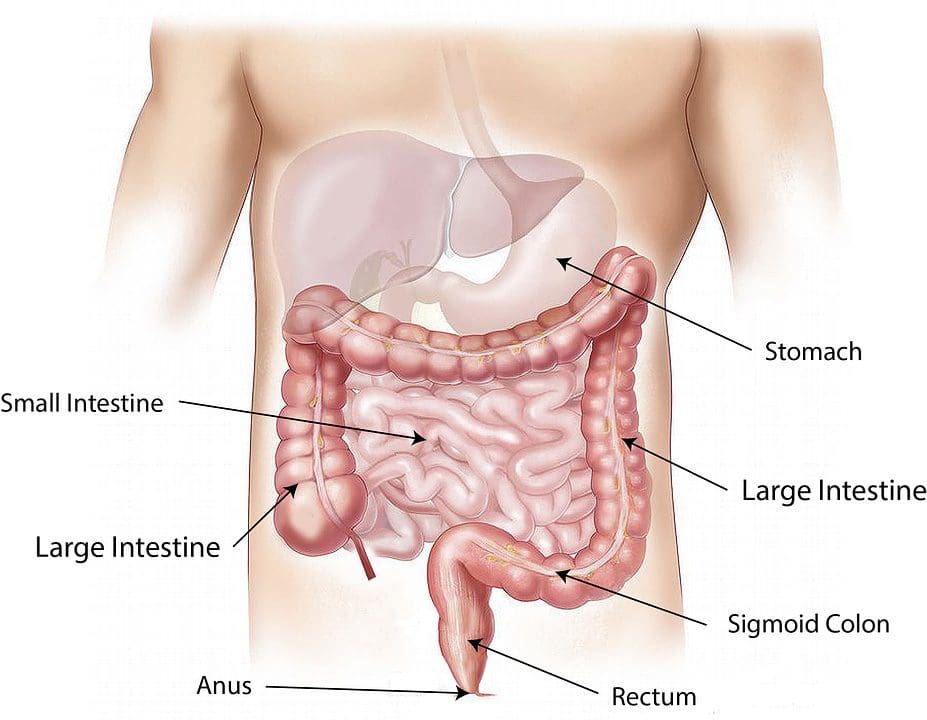 The very first crop submitted to the FDA�s voluntary consultation process, the FlavrSavr tomato, showed evidence of toxins. Out of 20 female rats fed the GM tomato, 7 developed stomach lesions.21 The director of FDA�s Office of Special Research Skills wrote that the tomatoes did not demonstrate a �reasonable certainty of no harm,�22 which is their normal standard of safety. The Additives Evaluation Branch agreed that �unresolved questions still remain.�23 The political appointees, however, did not require that the tomato be withdrawn.1
The very first crop submitted to the FDA�s voluntary consultation process, the FlavrSavr tomato, showed evidence of toxins. Out of 20 female rats fed the GM tomato, 7 developed stomach lesions.21 The director of FDA�s Office of Special Research Skills wrote that the tomatoes did not demonstrate a �reasonable certainty of no harm,�22 which is their normal standard of safety. The Additives Evaluation Branch agreed that �unresolved questions still remain.�23 The political appointees, however, did not require that the tomato be withdrawn.1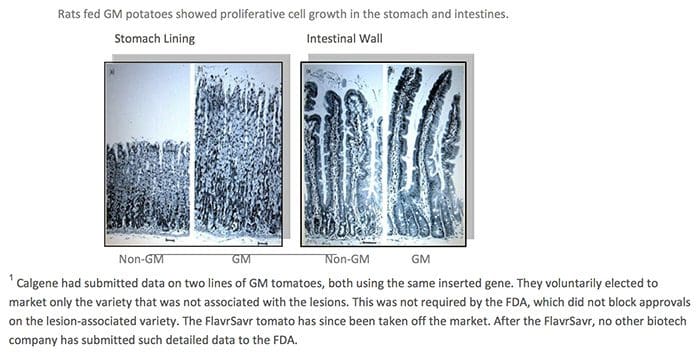 GM Diets Cause Liver Damage
GM Diets Cause Liver Damage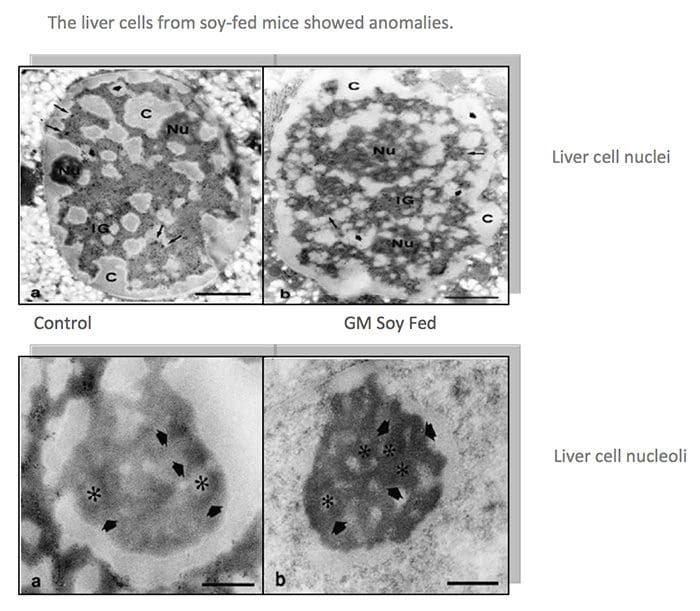
 GM Fed Animals Had Higher Death Rates & Organ Damage
GM Fed Animals Had Higher Death Rates & Organ Damage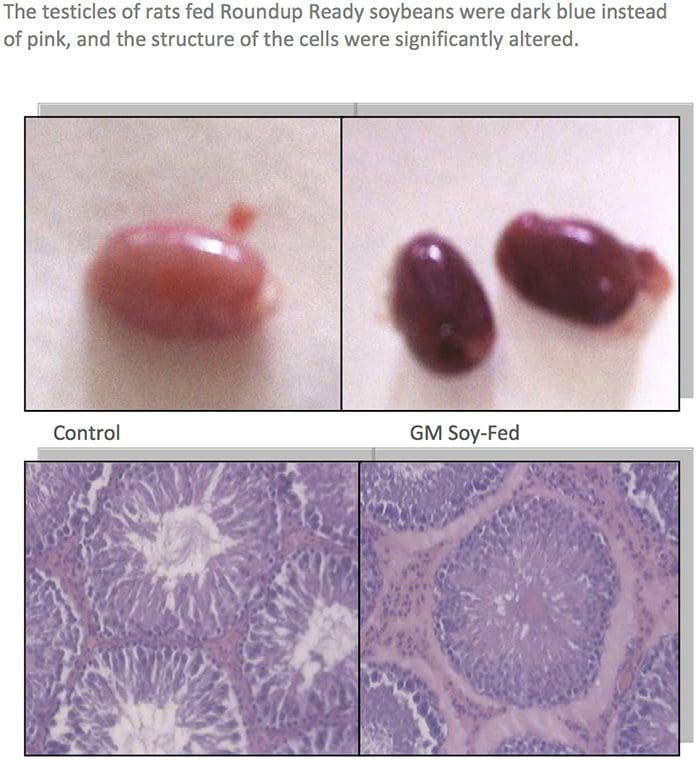
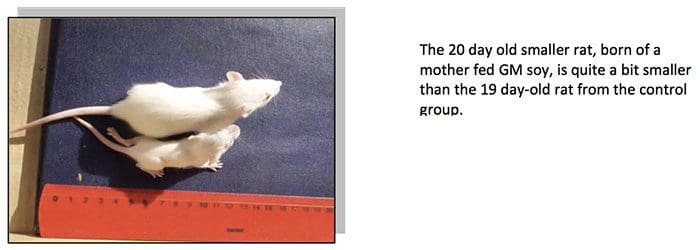
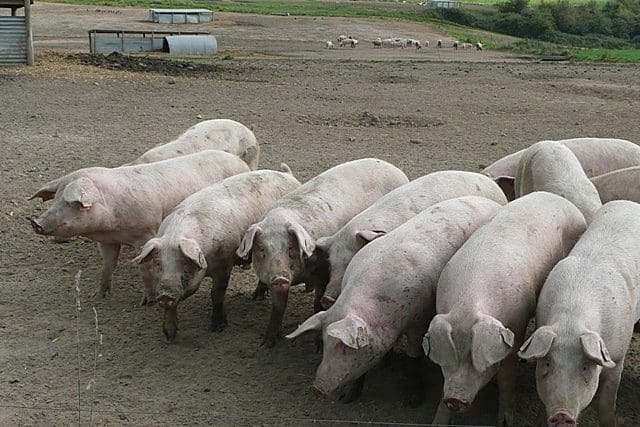 About two dozen farmers reported that their pigs had reproductive problems when fed certain varieties of Bt corn. Pigs were sterile, had false pregnancies, or gave birth to bags of water. Cows and bulls also became sterile. Bt corn was also implicated by farmers in the deaths of cows, horses, water buffaloes, and chickens.55
About two dozen farmers reported that their pigs had reproductive problems when fed certain varieties of Bt corn. Pigs were sterile, had false pregnancies, or gave birth to bags of water. Cows and bulls also became sterile. Bt corn was also implicated by farmers in the deaths of cows, horses, water buffaloes, and chickens.55 Allergic reactions occur when the immune system interprets something as foreign, different, and offensive, and reacts accordingly. All GM foods, by definition, have something foreign and different. And several studies show that they provoke reactions. Rats fed Monsanto�s GM corn, for example, had a significant increase in blood cells related to the immune system.58 GM potatoes caused the immune system of rats to respond more slowly.59 And GM peas provoked an inflammatory response in mice, suggesting that it might cause deadly allergic reactions in people.60
Allergic reactions occur when the immune system interprets something as foreign, different, and offensive, and reacts accordingly. All GM foods, by definition, have something foreign and different. And several studies show that they provoke reactions. Rats fed Monsanto�s GM corn, for example, had a significant increase in blood cells related to the immune system.58 GM potatoes caused the immune system of rats to respond more slowly.59 And GM peas provoked an inflammatory response in mice, suggesting that it might cause deadly allergic reactions in people.60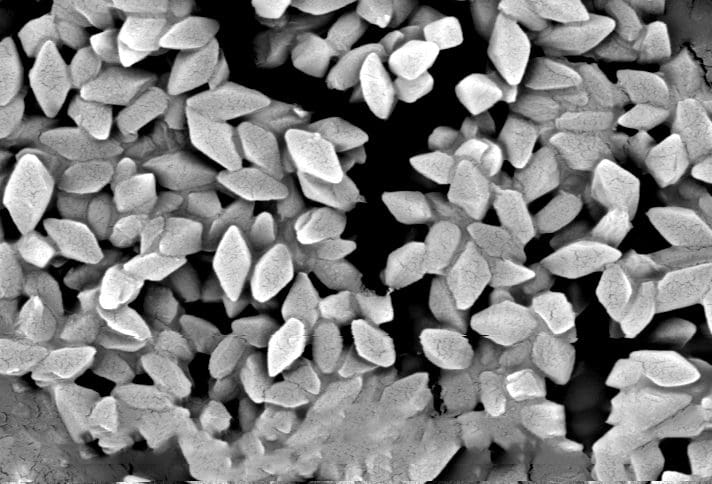 For years, organic farmers and others have sprayed crops with solutions containing natural Bt bacteria as a method of insect control. The toxin creates holes in their stomach and kills them. Genetic engineers take the gene that produces the toxin in bacteria and insert it into the DNA of crops so that the plant does the work, not the farmer. The fact that we consume that toxic pesticide in every bite of Bt corn is hardly appetizing.
For years, organic farmers and others have sprayed crops with solutions containing natural Bt bacteria as a method of insect control. The toxin creates holes in their stomach and kills them. Genetic engineers take the gene that produces the toxin in bacteria and insert it into the DNA of crops so that the plant does the work, not the farmer. The fact that we consume that toxic pesticide in every bite of Bt corn is hardly appetizing.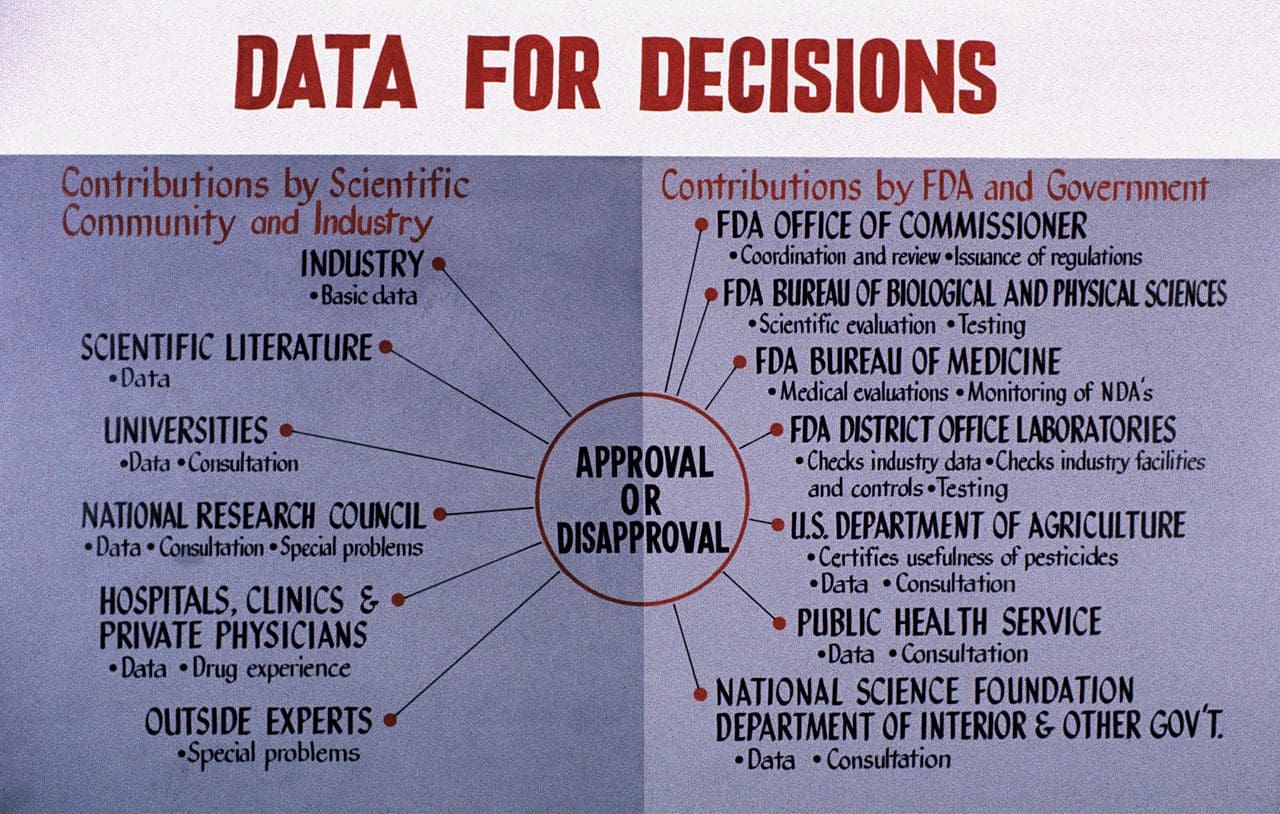 Although the number of safety studies on GM foods is quite small, it has validated the concerns expressed by FDA scientists and others. Unfortunately, government safety assessments worldwide are not competent to even identify most of the potential health problems described above, let alone protect its citizens from the effects.88
Although the number of safety studies on GM foods is quite small, it has validated the concerns expressed by FDA scientists and others. Unfortunately, government safety assessments worldwide are not competent to even identify most of the potential health problems described above, let alone protect its citizens from the effects.88 Submissions to the US Food and Drug Administraion (FDA) may be worse than in other countries, since the agency doesn�t actually require any data. Their policy says that biotech companies can determine if their own foods are safe. Anything submitted is voluntary and, according to former Environmental Protection Agency scientist Doug Gurian-Sherman, PhD, �often lack[s] sufficient detail, such as necessary statistical analyses needed for an adequate safety evaluation.� Using Freedom of Information Requests, Dr. Gurian-Sherman analyzed more than a fourth of the data summaries (14 of 53) of GM crops reviewed by the FDA. He says, �The FDA consultation process does not allow the agency to require submission of data, misses obvious errors in company- submitted data summaries, provides insufficient testing guidance, and does not require sufficiently detailed data to enable the FDA to assure that GE crops are safe to eat.�94 Similarly, a Friends of the Earth review of company and FDA documents concluded:
Submissions to the US Food and Drug Administraion (FDA) may be worse than in other countries, since the agency doesn�t actually require any data. Their policy says that biotech companies can determine if their own foods are safe. Anything submitted is voluntary and, according to former Environmental Protection Agency scientist Doug Gurian-Sherman, PhD, �often lack[s] sufficient detail, such as necessary statistical analyses needed for an adequate safety evaluation.� Using Freedom of Information Requests, Dr. Gurian-Sherman analyzed more than a fourth of the data summaries (14 of 53) of GM crops reviewed by the FDA. He says, �The FDA consultation process does not allow the agency to require submission of data, misses obvious errors in company- submitted data summaries, provides insufficient testing guidance, and does not require sufficiently detailed data to enable the FDA to assure that GE crops are safe to eat.�94 Similarly, a Friends of the Earth review of company and FDA documents concluded: The unpublished industry studies submitted to regulators are typically kept secret based on the claim that it is �confidential business information.� The Royal Society of Canada is one of many organizations that condemn this practice. They wrote:
The unpublished industry studies submitted to regulators are typically kept secret based on the claim that it is �confidential business information.� The Royal Society of Canada is one of many organizations that condemn this practice. They wrote: In addition, to relying on untested assumptions, industry-funded research is often designed specifically to force a conclusion of safety. In the high lysine corn described above, for example, the levels of certain nutritional components (i.e. protein content, total dietary fiber, acid detergent fiber, and neutral detergent fiber) were far outside the normal range for corn. Instead of comparing their corn to normal controls, which would reveal this disparity, Monsanto compared it to obscure corn varieties that were also substantially outside the normal range on precisely these values. Thus, their study found no statistical differences by design.
In addition, to relying on untested assumptions, industry-funded research is often designed specifically to force a conclusion of safety. In the high lysine corn described above, for example, the levels of certain nutritional components (i.e. protein content, total dietary fiber, acid detergent fiber, and neutral detergent fiber) were far outside the normal range for corn. Instead of comparing their corn to normal controls, which would reveal this disparity, Monsanto compared it to obscure corn varieties that were also substantially outside the normal range on precisely these values. Thus, their study found no statistical differences by design. Monsanto�s 1996 Journal of Nutrition studies on Roundup Ready soybeans107,108 provide plenty of examples of scientific transgressions. Although the study has been used often by the industry as validation for safety claims, experts working in the field were not impressed. For example, Dr. Arpad Pusztai was commissioned at the time by the UK government to lead a 20 member consortium in three institutions to develop rigorous testing protocols on GM foods�protocols that were never implemented. Dr. Pusztai, who had published several studies in that same nutrition journal, said the Monsanto paper was not �up to the normal journal standards.� He said, �It was obvious that the study had been designed to avoid finding any problems. Everybody in our consortium knew this.� Some of the flaws include:
Monsanto�s 1996 Journal of Nutrition studies on Roundup Ready soybeans107,108 provide plenty of examples of scientific transgressions. Although the study has been used often by the industry as validation for safety claims, experts working in the field were not impressed. For example, Dr. Arpad Pusztai was commissioned at the time by the UK government to lead a 20 member consortium in three institutions to develop rigorous testing protocols on GM foods�protocols that were never implemented. Dr. Pusztai, who had published several studies in that same nutrition journal, said the Monsanto paper was not �up to the normal journal standards.� He said, �It was obvious that the study had been designed to avoid finding any problems. Everybody in our consortium knew this.� Some of the flaws include: When governments fail in their duty to keep corporations in check, the �protector� role should shift to the media, which acts as a watchdog to expose public dangers and governmental shortcomings. But mainstream media around the world has largely overlooked the serious problems associated with GM crops and their regulation. The reason for this oversight is varied and includes contributions from an aggressive public relations and disinformation campaign by the biotech industry, legal threats by biotech companies, and in some cases, the fear of losing advertising accounts. This last reason is particularly prevalent among the farm press, which receives much of its income from the biotech industry.
When governments fail in their duty to keep corporations in check, the �protector� role should shift to the media, which acts as a watchdog to expose public dangers and governmental shortcomings. But mainstream media around the world has largely overlooked the serious problems associated with GM crops and their regulation. The reason for this oversight is varied and includes contributions from an aggressive public relations and disinformation campaign by the biotech industry, legal threats by biotech companies, and in some cases, the fear of losing advertising accounts. This last reason is particularly prevalent among the farm press, which receives much of its income from the biotech industry. One of the most troubling aspects of the biotech debate is the attack strategy used on GMO critics and independent scientists. Not only are adverse findings by independent scientists often suppressed, ignored, or denied, researchers that discover problems from GM foods have been fired, stripped of responsibilities, deprived of tenure, and even threatened. Consider Dr. Pusztai, the world�s leading scientist in his field, who inadvertently discovered in 1998 that unpredictable changes in GM crops caused massive damage in rats. He went public with his concerns, was a hero at his prestigious institute for two days, and then, after the director received two phone calls allegedly from the UK Prime Minister�s office, was fired after 35 years and silenced with threats of a lawsuit. False statements were circulated to trash his reputation, which are recited by GMO advocates today.
One of the most troubling aspects of the biotech debate is the attack strategy used on GMO critics and independent scientists. Not only are adverse findings by independent scientists often suppressed, ignored, or denied, researchers that discover problems from GM foods have been fired, stripped of responsibilities, deprived of tenure, and even threatened. Consider Dr. Pusztai, the world�s leading scientist in his field, who inadvertently discovered in 1998 that unpredictable changes in GM crops caused massive damage in rats. He went public with his concerns, was a hero at his prestigious institute for two days, and then, after the director received two phone calls allegedly from the UK Prime Minister�s office, was fired after 35 years and silenced with threats of a lawsuit. False statements were circulated to trash his reputation, which are recited by GMO advocates today. Since GM foods are not properly tested before they enter the market, consumers are the guinea pigs. But this doesn�t even qualify as an experiment. There are no controls and no monitoring. Given the mounting of evidence of harm, it is likely that GM foods are contributing to the deterioration of health in the United States, Canada, and other countries where it is consumed. But without post- marketing surveillance, the chances of tracing health problems to GM food are low. The incidence of a disease would have to increase dramatically before it was noticed, meaning that millions may have to get sick before a change is investigated. Tracking the impact of GM foods is even more difficult in North America, where the foods are not labeled.
Since GM foods are not properly tested before they enter the market, consumers are the guinea pigs. But this doesn�t even qualify as an experiment. There are no controls and no monitoring. Given the mounting of evidence of harm, it is likely that GM foods are contributing to the deterioration of health in the United States, Canada, and other countries where it is consumed. But without post- marketing surveillance, the chances of tracing health problems to GM food are low. The incidence of a disease would have to increase dramatically before it was noticed, meaning that millions may have to get sick before a change is investigated. Tracking the impact of GM foods is even more difficult in North America, where the foods are not labeled.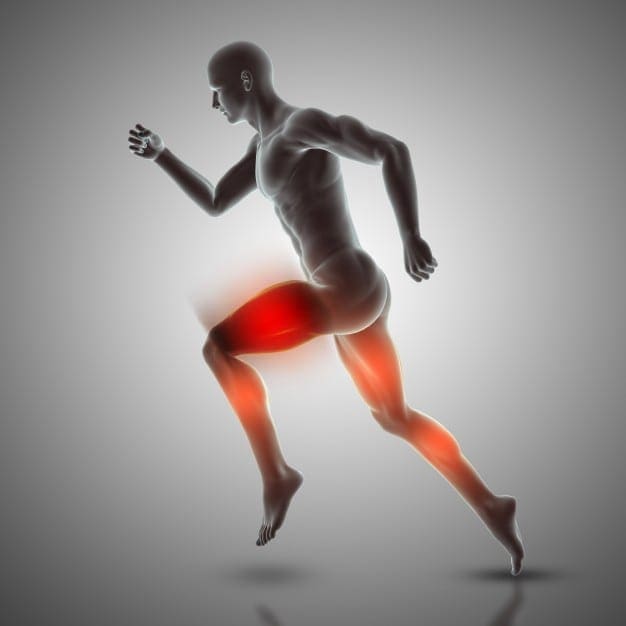
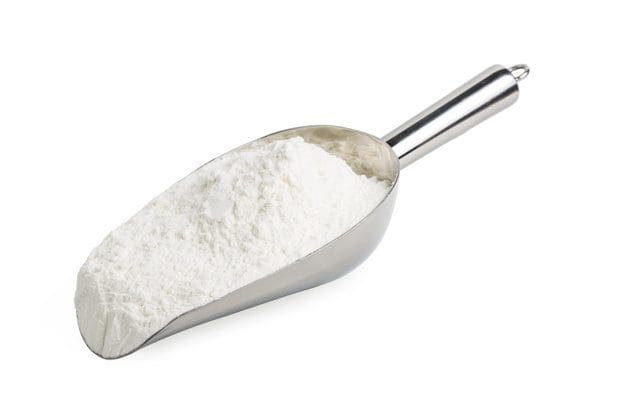 There are 3 known types of negative reactions to wheat proteins, collectively known as wheat protein reactivity: wheat allergy (WA), gluten sensitivity (GS),�and celiac disease (CD). Of the 3, only CD is known to involve autoimmune reactivity, generation of antibodies, and intestinal mucosal damage. Wheat allergy involves the release of histamine by way of immunoglobulin (Ig) E cross-linking with gluten peptides and presents within hours after ingestion of wheat proteins. Gluten sensitivity is considered to be a diagnosis of exclusion; sufferers improve symptomatically with a gluten-free diet (GFD) but do not express antibodies or IgE reactivity.1
There are 3 known types of negative reactions to wheat proteins, collectively known as wheat protein reactivity: wheat allergy (WA), gluten sensitivity (GS),�and celiac disease (CD). Of the 3, only CD is known to involve autoimmune reactivity, generation of antibodies, and intestinal mucosal damage. Wheat allergy involves the release of histamine by way of immunoglobulin (Ig) E cross-linking with gluten peptides and presents within hours after ingestion of wheat proteins. Gluten sensitivity is considered to be a diagnosis of exclusion; sufferers improve symptomatically with a gluten-free diet (GFD) but do not express antibodies or IgE reactivity.1 A 28-year-old man presented to a chiropractic teaching clinic with complaints of constant muscle fasciculations of 2 years� duration. The muscle fasciculations originally started in the left eye and remained there for about 6 months. The patient then noticed that the fasciculations began to move to other areas of his body. They first moved into the right eye, followed by the lips,�and then to the calves, quadriceps, and gluteus muscles. The twitching would sometimes occur in a single muscle or may involve all of the above muscles simultaneously. Along with the twitches, he reports a constant �buzzing� or �crawling� feeling in his legs. There was no point during the day or night when the twitches ceased.
A 28-year-old man presented to a chiropractic teaching clinic with complaints of constant muscle fasciculations of 2 years� duration. The muscle fasciculations originally started in the left eye and remained there for about 6 months. The patient then noticed that the fasciculations began to move to other areas of his body. They first moved into the right eye, followed by the lips,�and then to the calves, quadriceps, and gluteus muscles. The twitching would sometimes occur in a single muscle or may involve all of the above muscles simultaneously. Along with the twitches, he reports a constant �buzzing� or �crawling� feeling in his legs. There was no point during the day or night when the twitches ceased.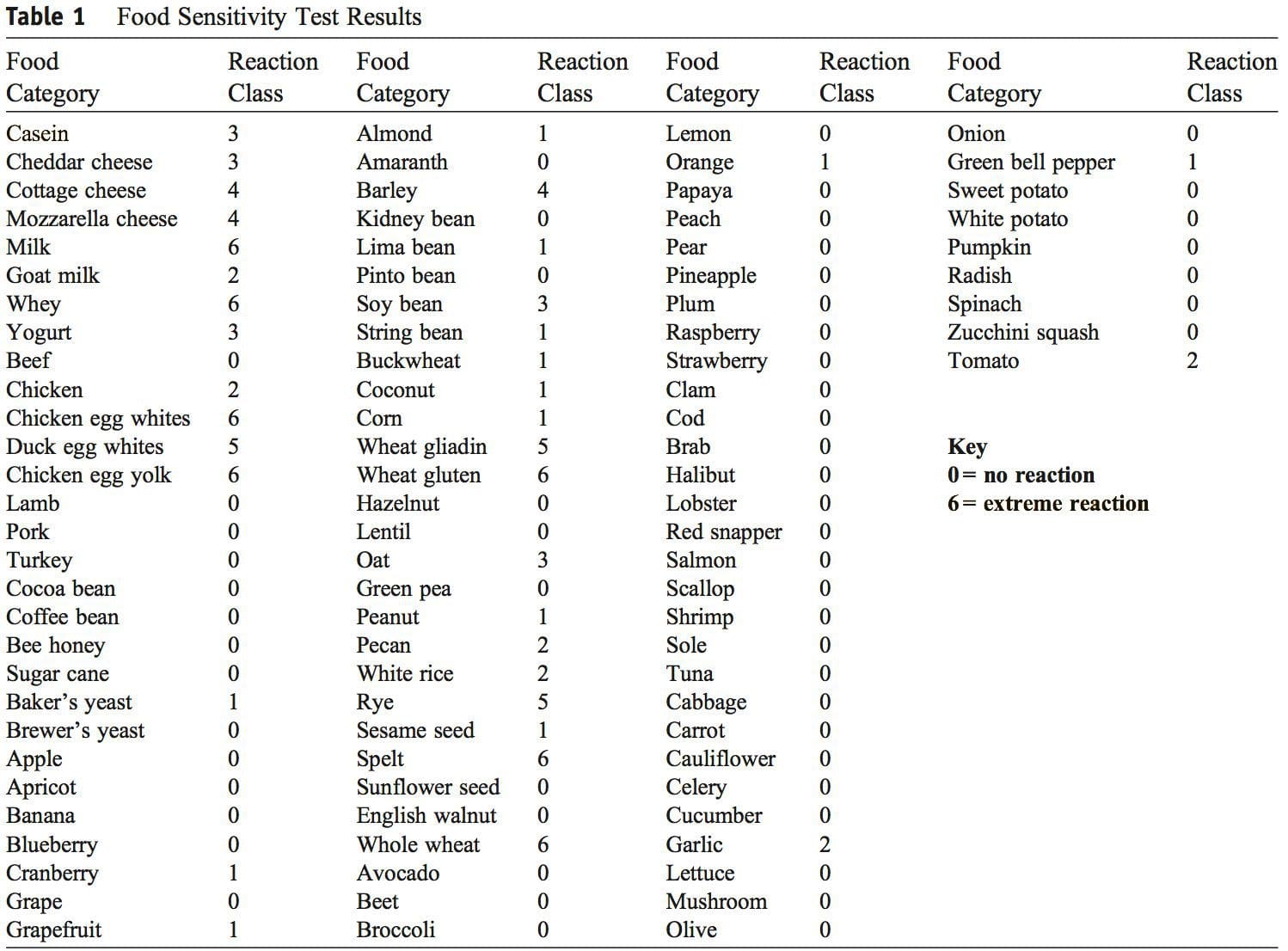 Discussion
Discussion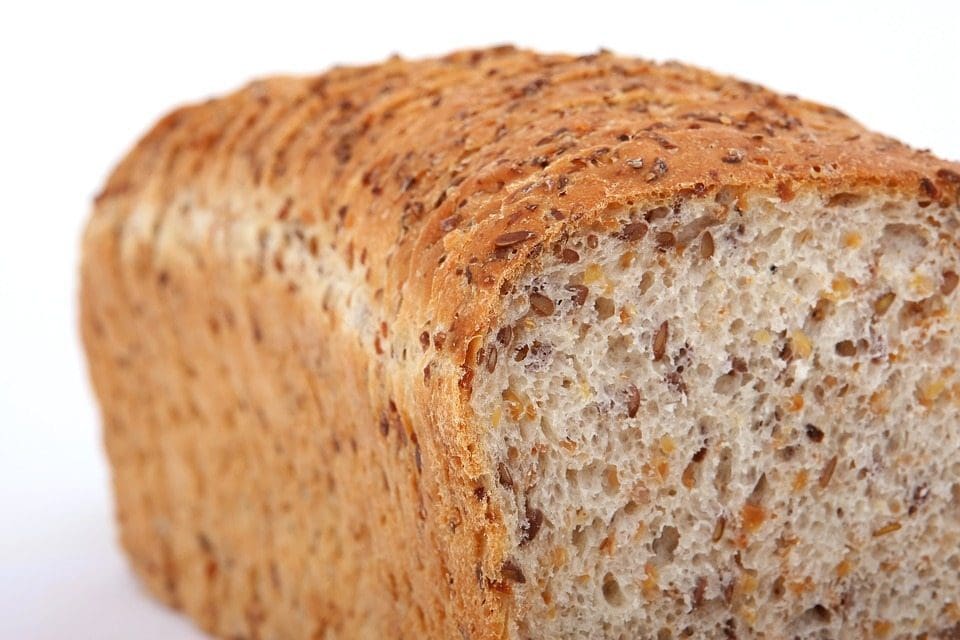 The authors could not find any published case studies related to a presentation such as the one�described here. We believe this is a unique presentation of wheat protein reactivity and thereby represents a contribution to the body of knowledge in this field.
The authors could not find any published case studies related to a presentation such as the one�described here. We believe this is a unique presentation of wheat protein reactivity and thereby represents a contribution to the body of knowledge in this field. This report describes improvement in chronic, widespread muscle fasciculations and various other systemic symptoms with dietary change. There is strong suspicion that this case represents one of
This report describes improvement in chronic, widespread muscle fasciculations and various other systemic symptoms with dietary change. There is strong suspicion that this case represents one of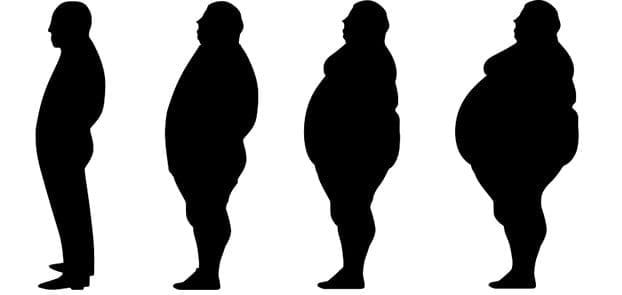
 The prevalence of obesity in the United States has been increasing for almost 50 years. Currently, more than two-thirds of adults and almost one-third of children and adolescents are
The prevalence of obesity in the United States has been increasing for almost 50 years. Currently, more than two-thirds of adults and almost one-third of children and adolescents are 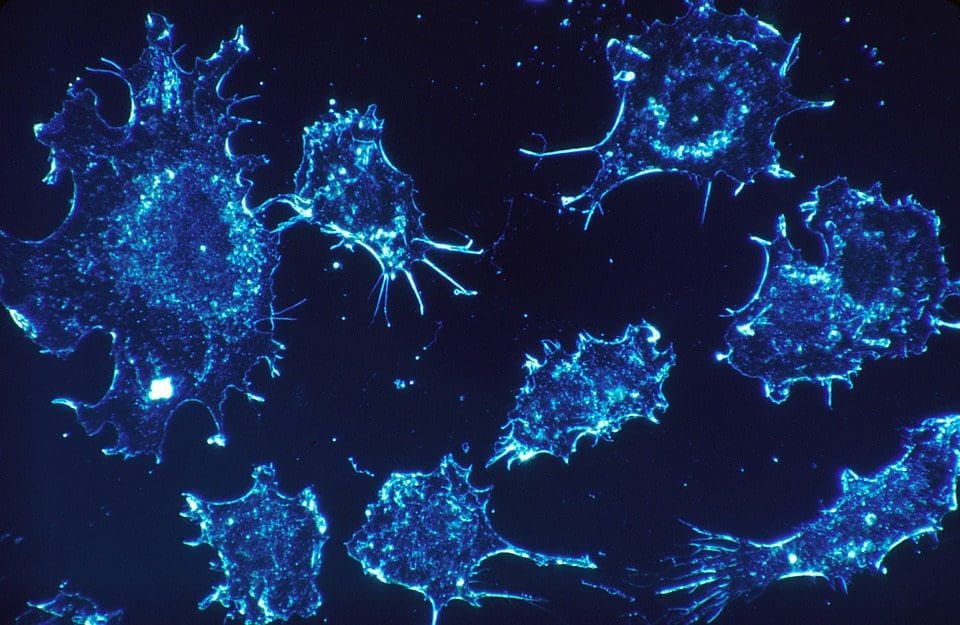
 From 2005 to 2014, there was a 1.4% annual increase in cancers related to overweight and obesity among individuals aged 20 to 49 years and a 0.4% increase in these cancers among individuals aged 50 to 64 years. For example, if cancer rates had stayed the same in 2014 as they were in 2005, there would have been 43?000 fewer cases of colorectal cancer but 33?000 more cases of other cancers related to overweight and obesity. Nearly half of all cancers in people younger than 65 years were associated with overweight and obesity. Overweight and obesity among younger people may exact a toll on individuals� health earlier in their lifetimes.
From 2005 to 2014, there was a 1.4% annual increase in cancers related to overweight and obesity among individuals aged 20 to 49 years and a 0.4% increase in these cancers among individuals aged 50 to 64 years. For example, if cancer rates had stayed the same in 2014 as they were in 2005, there would have been 43?000 fewer cases of colorectal cancer but 33?000 more cases of other cancers related to overweight and obesity. Nearly half of all cancers in people younger than 65 years were associated with overweight and obesity. Overweight and obesity among younger people may exact a toll on individuals� health earlier in their lifetimes.
 The
The  Implementation of clinical interventions, including screening, counseling, and referral, has major challenges. Since 2011, Medicare has covered behavioral counseling sessions for weight loss in primary care settings. However, the benefit has not been widely utilized.
Implementation of clinical interventions, including screening, counseling, and referral, has major challenges. Since 2011, Medicare has covered behavioral counseling sessions for weight loss in primary care settings. However, the benefit has not been widely utilized. Achieving sustainable weight loss requires comprehensive strategies that support patients� efforts to make significant lifestyle changes. The availability of clinical and community programs and services to which to refer patients is critically important. Although such programs are available in some communities, there are gaps in availability. Furthermore, even when these programs are available, enhancing linkages between clinical and community care could improve patients� access. Linking community obesity prevention, weight management, and physical activity programs with clinical services can connect people to valuable prevention and intervention resources in the communities where they live, work, and play. Such linkages can give individuals the encouragement they need for the lifestyle changes that maintain or improve their health.
Achieving sustainable weight loss requires comprehensive strategies that support patients� efforts to make significant lifestyle changes. The availability of clinical and community programs and services to which to refer patients is critically important. Although such programs are available in some communities, there are gaps in availability. Furthermore, even when these programs are available, enhancing linkages between clinical and community care could improve patients� access. Linking community obesity prevention, weight management, and physical activity programs with clinical services can connect people to valuable prevention and intervention resources in the communities where they live, work, and play. Such linkages can give individuals the encouragement they need for the lifestyle changes that maintain or improve their health. The high prevalence of overweight and obesity in the United States will continue to contribute to increases in health consequences related to obesity, including cancer. Nonetheless, cancer is not inevitable; it is possible that many cancers related to overweight and obesity could be prevented, and physicians have an important responsibility in educating patients and supporting patients� efforts to lead healthy lifestyles. It is important for all health care professionals to emphasize that along with quitting or avoiding tobacco, achieving and maintaining a healthy weight are also important for reducing the risk of cancer.
The high prevalence of overweight and obesity in the United States will continue to contribute to increases in health consequences related to obesity, including cancer. Nonetheless, cancer is not inevitable; it is possible that many cancers related to overweight and obesity could be prevented, and physicians have an important responsibility in educating patients and supporting patients� efforts to lead healthy lifestyles. It is important for all health care professionals to emphasize that along with quitting or avoiding tobacco, achieving and maintaining a healthy weight are also important for reducing the risk of cancer.